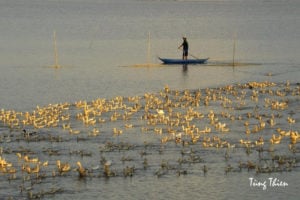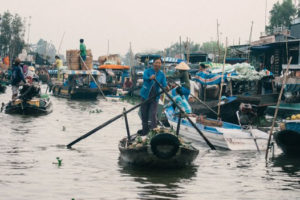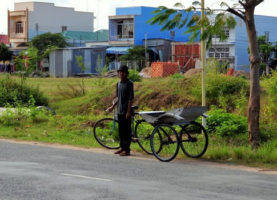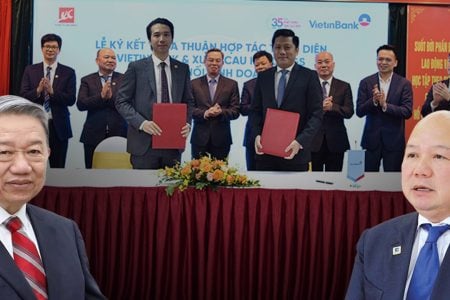
Mekong Delta – Rice granary of Vietnam
The southwestern region, also known as the „Mekong River Delta“ (Mekong Delta), is the richest delta most favored by nature in Vietnam. Folklore of the Mekong Delta is that a southern land is a place that never gets hungry because it is surrounded by rice fields and the immense Mekong River with 9 branches full of shrimp and fish all year round, the most in the flood season each year.
The Mekong Delta is considered the rice granary of Vietnam, making an important contribution for the nation to becoming one of the largest rice exporting countries in the world. This place is also a key agricultural development area with a variety of agricultural products, not only for the domestic consumption market but also for export to foreign countries.
During the 10 years from 2009 to 2019, the Mekong Delta region contributed 54% of the country’s rice production, 70% of the aquaculture production, 60% of the fruit production, and approximately 18% of Vietnam’s GDP.
According to statistics, recorded by the Central Population and Housing Census Steering Committee, in 2020, the population in the Mekong Delta is nearly 17.3 million, accounting for nearly 18% of the population of Vietnam. The population growth rate in the Mekong Delta in the past decade is the lowest in Vietnam, only 0.05%, while the aging index is the highest in the country at 58.5% and the net migration rate is also the highest in the country, at 39.9%. One of the reasons leading to these parameters is the „migration out of the region to do business by the working-age group.“

1.3 million people migrated in a decade
A journalist living in the Mekong Delta, currently working in the field of television reporting, on the evening of December 17, shared more relevant information about Western migrants, through his personal notes.
“Due to the rapid urbanization and the shift in the economic structure from the weakness of agriculture to trade, services and technology, the young workforce goes to the provinces with strong industrial development, as people say ‚Go to Binh Duong,‘ so young people of working age go to Binh Duong and Dong Nai to work, so the land is due to the elderly doing part-time work, not young people. As a result, the labor force in the Mekong Delta provinces is lost and is in the category of migration.”
The domestic media recently quoted the Chairman of Dong Thap province, Mr. Pham Thien Nghia, at the ceremony to announce the annual economic report of the Mekong Delta in 2020, held on the afternoon of December 14 in Can Tho, that “Saying the Mekong Delta is rich and has a lot of labors, but in sum, 10 years of migration over 1.3 million people is a very sad problem. Nearly 40% of workers have an only secondary school education, in today’s integrated society it is very painful.“
Television journalist, who did not want to name, shared with RFA that the Mekong Delta has many advantages in terms of the land fund, agricultural development and investment in science and technology by the state, especially human resources, a large ratio of young ones; however, the number of people in the Mekong Delta migrating up to more than million people because this area is facing many difficulties and challenges.
“Over the past 10 years, the first disadvantage has been climate change and inundation in some coastal provinces such as Ben Tre, Tien Giang, Bac Lieu, and Ca Mau. Saline water enters the orchard or other aquatic products, causing damage or death. In many cases, farmers suffer difficulties due to such climate change. There are also provinces that do not suffer from saline intrusion such as Dong Thap, An Giang … but suffer erosion and landslides due to changes in water flow. The reason for this change is sand exploitation, especially in the Cambodian watershed area, where too much sand is exploited, so many households have to live miserably due to the changing flow problem.”
The anonymous journalist also listed the state of hydroelectric dams being built in China and Laos, the upper Mekong region causing drought and the disappearance of silt. In addition, the dyke system is more and more, along with farmers increasing crop productivity by chemical fertilizers, releasing water flows that pollute the environment and the opposite impact of irrigation water systems, making the agricultural sector in the Mekong Delta suffered heavy losses.

In 2016, Vietnam’s Ministry of Natural Resources and Environment released a report showing that hydropower dams on the Mekong mainstream pose the risk of losing or even extinction up to 10% of fish species and the income of the local people can reduce up to 50%. Vietnam suffers from annual losses in fisheries and agriculture, because of those dams, and the losses can amount to about $760 million.
Mrs. Kim, a farmer in Ben Tre, on the evening of December 17, told RFA that her family could not make ends meet from farm income, so she had to find work abroad.
“I had to work as a worker in Dong Nai in 2008. The salary at that time was only 38,000 dongs/working day for 8 hours. For the past ten or a few years, I have not had enough to live, so it is very miserable and I have to try hard.“
Ms. Anh, a resident of Dong Thap who left her hometown to work in Kinh Do Company, in Binh Duong Industrial Park since 2001, confided in RFA about her working life:
“Looks like nearly 6 million/month. If they work overtime, they can receive up to VND7.8 million, sometimes up to VND10 million, working 12 hours a day, from 6 am to 6 pm.
Ms. Anh’s life was good when she could afford to herself and send money back home to support her sick, single elderly mother. However, in early 2020, Anh was forced to return to her hometown to live, to take care of her mother because she had a car crash, and she could not walk. Although during the COVID-19 epidemic, Anh also found a job as a cleaning worker in a company, thanks to the recommendation of her neighbor.
“Now I am working on a salary of VND3.5 million/month. I have to pay for electricity, water, food, and medicine bills. Not to mention much when I was sick so I don’t have enough for bills.”
Mr. K, an executive director of a private company, trading in real estate projects in the Mekong Delta, told RFA about the current employment situation in this area:
“The Mekong Delta has been both affected by the COVID-19 pandemic and saline intrusion which has severely affected agriculture. COVID-19 has also caused serious consequences for the young qualified workforce, for unskilled labor is much worse. The 1.3 million migrants are just a very modest reflection.”
Mr. Nguyen Phuong Lam, deputy director of the Chamber of Commerce and Industry of Can Tho branch, on December 17, in a reply to VnEXpress online newspaper that the fact that Western people have left too much in a certain period of time shows that is a pressing situation and this land is underdeveloped. In the long run, if not resolved, society will be unstable.

What is the outlook for the Mekong Delta?
The salty drought season in 2020 in the Mekong Delta is assessed as „extreme“ and Prime Minister Nguyen Xuan Phuc, in early August, made a decision to spend the budget on 5 damaged provinces including Ben Tre, Tien Giang, Long An, Ca Mau, Kien Giang with the amount of VND70 billion/province to support water source for domestic use and people’s life.
At the beginning of last November, at a questioning session of the parliament, Prime Minister Nguyen Xuan Phuc also announced that the Government would pay special attention to and devote worthy resources to invest in infrastructure in the Mekong Delta, before the impact of climate change. After all, sea-level rise as well as weak infrastructure due to inadequate investment in the region’s development needs. At the same time, the PM also agreed to increase an additional $2 billion for the planning of the Mekong Delta by 2030, with a vision to 2050.
An anonymous television journalist confirmed to RFA that the current authorities of the provinces and cities in the Mekong Delta are implementing many projects according to the plan just mentioned. He said that the Mekong Delta in the future will focus on the development of industry, commerce, and tourism services. In particular, the agricultural sector will shift towards clean agriculture according to international standards to meet export markets such as the US and the EU.
Young architect Duy Black, currently living and working in Saigon, told RFA that he and many of his children in the southwestern region will surely return home if the area is invested and developed as planned:
„Of course. Regardless, everyone wants to be near their hometown and if they have a good opportunity to develop, they will return to develop their career and settle down. If the state invests well, methodically, and develops sustainably, everyone will return. However, it’s actually a bit difficult because according to scientific bases, the southwestern region is slowly dying out.”
The state-controlled media in June 2019 quoted Director of the Department of Disaster Safety Control Mr. Tang Quoc Chinh said earlier in February, Utrecht University, of the Netherlands, published a study on the level of subsidence in the Mekong Delta and give warnings with the current level of subsidence, by 2100 nearly the entire Mekong Delta of Vietnam will be submerged under the water.
RFA radio borrowed words from an anonymous TV journalist to end this report, that in the „dark picture“ of social life in the Mekong Delta, he sympathized with migrants like Anh and dozens of people. Thousands of „brides“ in the West have to go to find a piece of rice and are more compassionate about their return, in which there are ashes of life like a branch of water hyacinths floating on the dying Mekong River.
Thoibao.de (Translated)




























